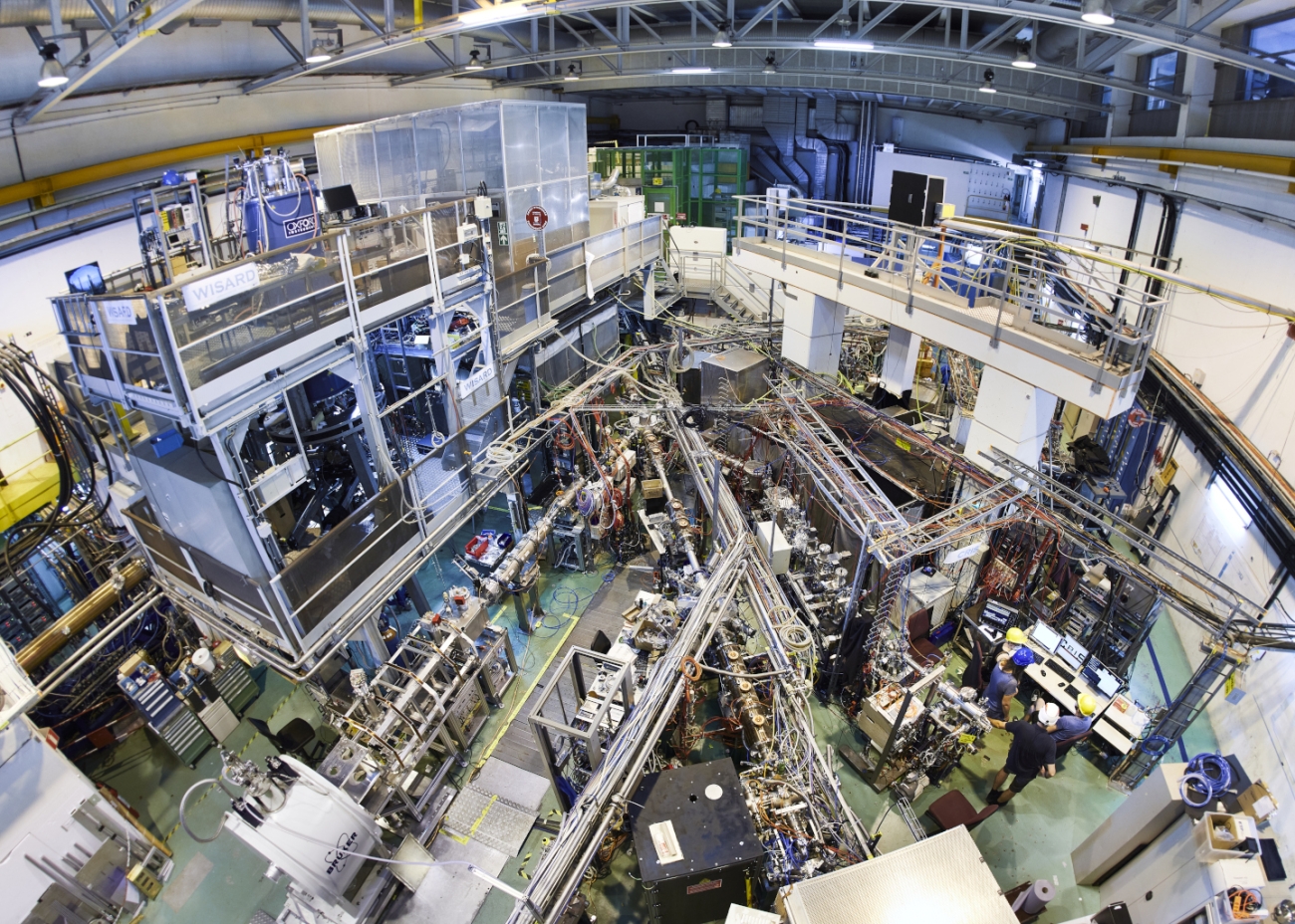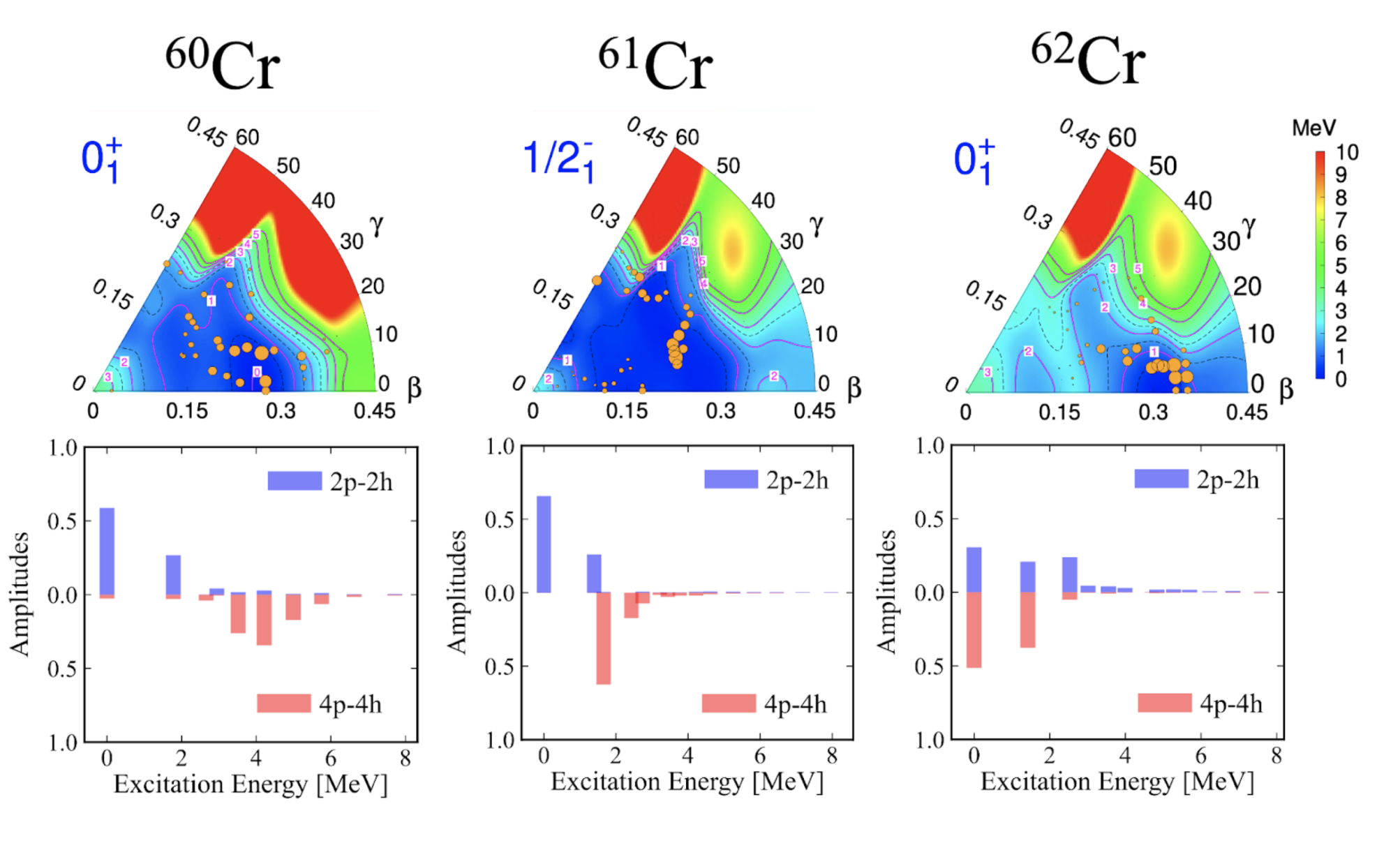ISOLDE charts the shores of the islands of inversion

For decades, CERN’s ISOLDE (Isotope Separator On-Line Device) facility has been a global leader in exploring the behaviour of exotic nuclei far from stability. By delivering beams of short-lived isotopes and enabling their study with advanced spectroscopic techniques, ISOLDE has expanded our view on nuclear structure and reshaped our understanding of how protons and neutrons organise themselves inside the nucleus.
This year, ISOLDE has once again delivered a landmark result: the first direct measurement of the ground-state spin and magnetic dipole moment of chromium-61 (61Cr). Published in Physical Review C as an Editors’ Suggestion, the study shows that 61Cr lies at the western entrance of the N=40 island of inversion, a region where the usual ordering of nuclear shell filling collapses and deformation dominates. The finding not only resolves long-standing uncertainties about 61Cr’s structure but also provides a critical benchmark for theories describing the rapid shape evolution of neutron-rich nuclei.
Magic numbers under stress
The nuclear shell model, developed in the 1940s, predicts that certain numbers of protons or neutrons – the so-called magic numbers – confer special stability. Like noble gases in atomic physics, nuclei with these filled shells are expected to be spherical and more stable than their neighbors. The well-established magic numbers include 2, 8, 20, 28, 50, 82 and 126 for neutrons.
However, as nuclear physicists have long known, these rules can bend – and even break – at the extremes of the nuclear chart. Far from stability, strong correlations between nucleons can upset the expected ordering of shell filling. Neutrons may cross the nominal shell gap into higher orbitals, forming intruder configurations that deform the nucleus. These anomalies cluster in small regions known as “islands of inversion”, where deformation replaces sphericity as the dominant structural feature.
To date, four such islands have been identified, associated with neutron numbers N=8, 20, 28 and 40. Each has become a testing ground for nuclear theory, forcing refinements to models that aim to capture both microscopic interactions and macroscopic shapes.
A new look at chromium-61
The chromium isotopes (Z=24) are particularly revealing in the region of N=40. Previous studies showed that isotopes like 62Cr and 64Cr are strongly deformed, their structures dominated by four-particle–four-hole (4p–4h) excitations across the N=40 subshell gap. By contrast, lighter isotopes such as 60Cr show weaker collectivity. This suggested a rapid transition in shape and configuration as neutrons are added.
At the centre of this transition sits chromium-61 (61Cr, 24 protons and 37 neutrons) – a nucleus thought to straddle the edge of the island of inversion. Yet until now, its structure had remained poorly understood. While its mass and lifetime were known, its ground-state spin had only been tentatively assigned as 5/2− from beta-decay studies. This left uncertainties in interpreting neighbouring isotopes and hindered the construction of a coherent picture of the N=40 region.
High-precision spectroscopy with CRIS
To tackle the problem, an international collaboration led by Louis Lalanne (KU Leuven, ISOLDE and Université de Strasbourg) turned to ISOLDE’s Collinear Resonance Ionisation Spectroscopy (CRIS) apparatus. CRIS is one of the most powerful techniques for probing the structure of exotic isotopes, combining resolution collinear laser spectroscopy with the sensitivity of resonant ionisation.
The experiment began by producing beams of 61Cr at ISOLDE. A 1.4 GeV proton beam from CERN’s PS Booster was directed onto a thick uranium-carbide target, producing a wealth of fission fragments. Chromium atoms were selectively ionised using ISOLDE’s Resonant Ionisation Laser Ion Source (RILIS), then mass-separated, cooled, and bunched before being delivered to the CRIS beam line.

Top panel: Schematic view of the CRIS experiment at ISOLDE (see text for details).Bottom panel: Hyperfine spectrum of 61Cr, obtained by recording ion counts as a function of the first-step laser frequency. The inset shows the laser ionisation scheme used. The two-peak structure is the signature of the nuclear spin I = 1/2, while the relative splitting of the peaks provides the magnetic dipole moment.
At CRIS, the ions were neutralised and exposed to carefully timed laser pulses tuned to specific atomic transitions. By measuring the hyperfine structure of the laser-induced signals, the team could extract the nuclear spin and magnetic dipole moment of 61Cr with high precision.
The results of the experiment on chromium-61 were strikingly clear. The ground state was determined to have spin and parity Iπ = 1/2−, rather than the previously assumed 5/2−. Its magnetic dipole moment was measured at +0.541(6) μN, a value consistent with a configuration dominated by an unpaired neutron in the p1/2 orbital. This new assignment has important consequences: it not only revises the level scheme of 61Cr but also compels a reinterpretation of earlier beta-decay studies that had been analysed under the assumption of a 5/2− ground state.
Theoretical calculations provided further support. Large-scale shell-model computations, combined with the recently developed Discrete Non Orthogonal Shell-Model, showed that the structure of 61Cr is driven by two-particle–two-hole neutron excitations across the N=40 subshell gap. The models also indicate that the nucleus adopts a triaxial shape – neither perfectly spherical nor simply deformed along one axis, but lying in between, a transitional geometry that underscores the complexity of the region.

Top panel: Deformation plots of 60Cr, 61Cr, and 62Cr calculated with the Discrete Non-Orthogonal Shell Model. The horizontal axis (β) shows the magnitude of the deformation, while the angle axis (γ) indicates the shape: γ = 0° corresponds to prolate (elongated), γ = 60° to oblate (flattened), and intermediate values to triaxial shapes.
Bottom panel: Evolution of the intruder configuration content as a function of excitation energy, obtained from large-scale shell model calculations. At zero excitation energy (the ground state), a sharp transition occurs between 61Cr and 62Cr: the dominant configuration changes from 2p–2h to 4p–4h. This configuration shift is directly linked to the shape transition, from a triaxial ground state in 61Cr to a strongly prolate ground state in 62Cr.
Adding just one neutron makes a decisive difference. Isotopes such as 62Cr already display ground states dominated by four-particle–four-hole excitations and are strongly deformed. Chromium-61 thus emerges as the last isotope in the chain whose structure is governed by the 2p–2h configuration, marking the western boundary of the N=40 island of inversion. The change is not abrupt, but gradual, with a continuous mixing of configurations that bears the hallmarks of a second-order quantum phase transition. This kind of soft but fundamental shift has been observed in other regions of the nuclear chart and reveals the richness of collective behaviour at the limits of stability.
Seen in a wider perspective, the chromium-61 result resonates with an earlier milestone at ISOLDE: the discovery of the spherical excited state in magnesium-32, which confirmed the onset of inversion at N=20. Both cases capture nuclei caught at a turning point, where established shell closures give way to new structural regimes. Together, they highlight ISOLDE’s unique role in revealing how the delicate interplay of nucleon interactions reshapes nuclear matter.
By pinning down the properties of chromium-61, ISOLDE has provided a precise marker on the map of the N=40 island of inversion. This benchmark is essential for the refinement of nuclear models that seek to unify the description of shell evolution, deformation and collective effects across the chart of nuclides.
The work also opens new lines of enquiry. The revised spin assignment calls for a fresh look at beta-decay data and points to the need for further decay-spectroscopy studies, particularly of chromium-61 and its neighbour vanadium-61. Transfer-reaction experiments could offer complementary confirmation of the intruder configurations and provide further insight into the shape evolution of this transitional region. On the theoretical side, the ability of the DNO-SM approach to capture the gradual onset of deformation underlines the value of frameworks that bridge the gap between microscopic excitations and macroscopic shapes. Extending these methods to heavier nuclei will be key to understanding the full scope of structural evolution.
With this new result, ISOLDE has once again shown why it remains a leading facility for nuclear physics worldwide. The marriage of high-intensity radioactive beams, innovative laser spectroscopy and advanced theory has opened a new window on some of the most neutron-rich isotopes accessible today. From the pioneering studies of magnesium at N=20 to the present work on chromium at N=40, ISOLDE continues to reveal how magic numbers dissolve and new structural regimes emerge. As the facility evolves further, and as complementary experiments elsewhere come online, the exploration of exotic nuclei promises to remain one of the most dynamic frontiers in physics.
Read more
For further details, see the published article in Physical Review C and learn more about the ISOLDE facility at CERN.
This work has received support from the European Union’s Horizon Europe research and innovation programme under Grant Agreement No. 101057511 (EURO-LABS).
Note: The author would like to thank Dr. Louis Lalanne, Researcher Physicist at CNRS, for his thoughtful comments and input in preparing the final version of this article.
